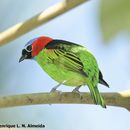-
There are three different songs here sung by a Western Meadowlark. The first repeats three times, the second song repeats 4 times, and the third song is repeated three times. This was recorded on Marble Hot Springs Road at the 2nd 90 degree turn as the Meadowlark sang from the telephone wire above. In the background you will hear cows moo and a few other birds call as well, but the Western Meadowlark is clearly the focal subject of the recording. This was recorded with a Fostex FR-2 and Sennheiser shotgun microphone, ME66.
The photo attached is a spectrogram of Western Meadowlark made in Raven Pro.
(taxonomy:binomial="Sturnella neglecta")
-
Every morning when he walks the dog, retired professor of natural history Peter Slater can identify as many as thirty birds by their song alone. On a walk in a Scottish town with Ari Daniel Shapiro, Slater explains what two common songsters, the chaffinch and winter wren, are singing about, and how even city dwellers can learn to “bird by ear” in their own neighborhoods, with rewarding results.
Download a transcript of the podcast Chaffinch, Photo Credit: Blake Matheson
read moreDuration: 5:21Published: Wed, 23 Jan 2013 20:30:18 +0000
-
A Red-winged Blackbird (Agelaius phoeniceus) sings atop a fence at a small finca (farm) near Fortuna Falls. This was the only singing red-wing that I found on the 6/98 trip. His song and calls are "thin" compared to ours in the US, but I have only this one sample to go by.
-
Red-winged blackbirds (Agelaius phoeniceus) inhabit the marshes around Peck's Lake [Arizona] along with their cousins, the Yellow-Headed Blackbirds. They have several vocalizations, three of which are represented in this sample.
-
And here are "Four and Twenty" Blackbirds (Red-Winged) all singing at once.
-
Here's that gurgling song that everyone associates with wetlands. This one is in Peck's Lake [Arizona] in mid-March, staking his claim on a prime piece of marshy real estate. Listen for his "chacks" and whistles between the loud calls.
-
This unusual "piping" by a male Red-winged Blackbird was directed at an interloping male. The calls were actually about 5 seconds apart, but I took out some silence in the interest of bandwidth here. I'd not heard this call used to warn another male before, but the intruder got the point and soon left the area.
-
Another group songfest - this time from a "Lek" of 25 or so Red-wings in the morning. I'm not sure this is a true Lek, but the ingredients are all there - lots of males (2/3 of those in attendance are male) singing with lots of females listening, and since it's in the Spring (2/16/99) and in the morning, it seems like Lek behavior. Note the silence midway through the sample - sudden and almost orchestrated - something distracted them for a moment.
-
In this sample a young male seems to "stutter" when he calls - recorded near Pinal Air Park, southern Arizona, 4/99.
-
A Yellow-billed Cacique (Amblycercus holosericeus) calls in the early morning rain in the gallery of the Sarapiqui at El Gavilan, near Puerto Viejo de Sarapiqui (Costa Rica), 11/16/98.
-
Golden Crowned Warblers (Basileuterus culicivorus) call and sing as they forage above our heads through the trees at Guayabo Nat'l Park (Costa Rica), 6/25/99.
-
Rufous-capped Warblers (Basileuterus rufifrons) are common residents on the Pacific slope and central highlands. We ran into this one at San Mateo, north of Carara (Costa Rica) - this is just the call note.
-
Three-striped Warblers (Basileuterus tristriatus) are pretty common in Monteverde (Costa Rica).
-
Scarlet-rumped Caciques (Cacicus uropygialis) are usually black-rumped, as the scarlet feathers are normally hidden away. Their calls are characteristically quavering. (Costa Rica)
-
Scarlet-rumped Cacique (Cacicus uropygialis) call, recorded at El Pizote, near Puerto Viejo de Talamanca (Costa Rica), 6/21/99.
-
Scarlet-rumped Cacique (Cacicus uropygialis). In this example, the singer "called in" another Scarlet-rumped Cacique, who gave the second group of calls and they flew off together, at El Pizote (Costa Rica).
-
A magnificent Cardinal sings his "pretty, pretty, pretty..".
-
The first, and often only, sounds you'll hear from Cardinals are their piping notes. The birds don't seem to be able to go anywhere without piping. This sample is of a male.
-
This female Cardinal gives us some of her vocalizations. Recorded 10/21/97 at Peck's Lake [Arizona].
-
Recorded at noon in a patch of Paradise Trees near Clarkdale, Central Arizona, June 1997.
-
This Black-faced Grosbeak (Caryothraustes poliogaster) calls in the forest at La Selva (Costa Rica).
-
This Bananaquit (Coereba flaveola) was foraging amongst the palms and Cecropia trees in Manuel Antonio (Costa Rica) - though he could have been recorded in any of the warmer areas of the country. The Bananaquit is the sole representative of his family, the Coerebidae.
-
Here is a courtship duet by two Bananaquits (Coereba flaveola), during which these birds were copulating. The Bananaquit is the sole representative of his family, the Coerebidae.
-
These Blue-black Grosbeaks (Cyanocompsa cyanoides) joined us as part of a mixed flock at La Selva (Costa Rica) in June, 1999. This is their typical chatter.

